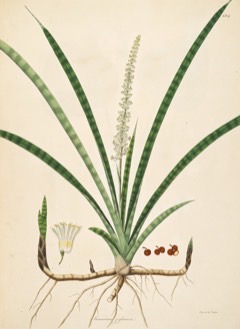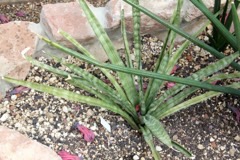 |
|
edibleplants.org |
 |
| Wikimedia.org - Peter A. Mansfeld |
Translate this page:
Summary
Physical Characteristics

 Sansevieria roxburghiana is an evergreen Perennial growing to 1 m (3ft 3in) by 1 m (3ft 3in) at a fast rate.
Sansevieria roxburghiana is an evergreen Perennial growing to 1 m (3ft 3in) by 1 m (3ft 3in) at a fast rate.
See above for USDA hardiness. It is hardy to UK zone 10.
Suitable for: light (sandy) and medium (loamy) soils and prefers well-drained soil. Suitable pH: neutral and basic (mildly alkaline) soils. It can grow in semi-shade (light woodland) or no shade. It prefers dry or moist soil and can tolerate drought.
UK Hardiness Map
US Hardiness Map
Synonyms
Acyntha roxburghiana (Schult. & Schult.f.) Kuntze Cordyline roxburghiana (Schult. & Schult.f.) Merr. Sansevieria zeylanica Roxb.
Plant Habitats
Edible Uses
References More on Edible Uses
Medicinal Uses
Plants For A Future can not take any responsibility for any adverse effects from the use of plants. Always seek advice from a professional before using a plant medicinally.
It has various traditional uses and recently various pharmacological uses are pursuing. Traditionally it is used as a cardiotonic, expectorant, febrifuge, purgative, tonic in glandular enlargement and rheumatism etc. The plant is known to possess antitumor, antibacterial, antidiabetic, antimicrobial, anticancer, antioxidant and analgesic activity. It contains carbohydrates, alkaloids, flavonoids, tannins, saponins, carotenoids gallic acid, palmitic acid, caft aric acid, isorahmnitin-3-O-ß-D glucopyranoside, buphanidine, diethyl ph thalate, 6-methyl-1-octanol, 3,3-dimethylhexanal, proteins, and phytosterols. It also contains a rare homoisoflavonoid Cambodianol.
References More on Medicinal Uses
The Bookshop: Edible Plant Books
Our Latest books on Perennial Plants For Food Forests and Permaculture Gardens in paperback or digital formats.

Edible Tropical Plants
Food Forest Plants for Hotter Conditions: 250+ Plants For Tropical Food Forests & Permaculture Gardens.
More

Edible Temperate Plants
Plants for Your Food Forest: 500 Plants for Temperate Food Forests & Permaculture Gardens.
More

More Books
PFAF have eight books available in paperback and digital formats. Browse the shop for more information.
Shop Now
Other Uses
A good quality fibre is obtained from the leaves[454 ]. The fibre is pliant, soft, and silky[454 ]. The natural elasticity of the fibre makes it suitable for making bowstrings[454 ]. The fibre is used for the preparation of cordage and matting in the regions where it occurs, and is much valued in Europe for ropes used in deep-sea dredging[454 ]. It has been used for making paper, but is too expensive a fibre for this use[454 ]. The fibre is usually prepared by taking the fresh leaves and placing one of them on a smooth board which is raised at one end. The lower end of the leaf is then pressed down by the toe of the workman, who squats on the plank, and with a blunt knife, or piece of iron plate scrapes upward along the surface of the leaf and thus deprives it of its fleshy pulp by successive scrapings, turning the leaf over and over, as may be necessary. When the pulp is thoroughly removed, the fibre is washed for three or four minutes, and dried in the shade[454 ]. Washing in brackish or salt water, or continuous soaking in water is said to destroy the glossy white appearance of this fibre[454 ]. Industrial Crop: Fiber.
Special Uses
Carbon Farming
References More on Other Uses
Cultivation details
Industrial Crop: Fiber Management: Hay Minor Global Crop
Subtropical to tropical climate in semi-arid to humid locations. Requires a sunny position in a well-drained soil[200 ]. Prefers a pH in the range 6 - 7[200 ]. Established plants are very drought tolerant[200 ]. The plant can spread freely at the roots.
Carbon Farming
-
Industrial Crop: Fiber
Clothing, rugs, sheets, blankets etc. Currently, almost none of our fiber are produced from perennial crops but could be!
-
Management: Hay
Cut to the ground and harvested annually. Non-destructive management systems maintaining the soil organic carbon.
-
Minor Global Crop
These crops are already grown or traded around the world, but on a smaller scale than the global perennial staple and industrial crops, The annual value of a minor global crop is under $1 billion US. Examples include shea, carob, Brazil nuts and fibers such as ramie and sisal.
References Carbon Farming Information and Carbon Sequestration Information
Temperature Converter
Type a value in the Celsius field to convert the value to Fahrenheit:
Fahrenheit:
The PFAF Bookshop
Plants For A Future have a number of books available in paperback and digital form. Book titles include Edible Plants, Edible Perennials, Edible Trees,Edible Shrubs, Woodland Gardening, and Temperate Food Forest Plants. Our new book is Food Forest Plants For Hotter Conditions (Tropical and Sub-Tropical).
Shop Now
Plant Propagation
Seed - Division of the rootstock. Leaf cuttings. Cut the leaf into sections about 5cm long, place in a 2:1 mix of sand and peat in a propagating case with a bottom heat of 18°c[200 ].
Other Names
If available other names are mentioned here
Common name: Indian Bowstring Hemp, Bowstring Hemp • Hindi: Marul, Murahri, Murva • Kannada: Heggurutike • Malayalam: Hatukapel • Marathi: Murhari • Sanskrit: Muruva • Tamil: Marul-kalang • Telugu: Ishaura-koda-udr
Native Range
TROPICAL ASIA: India
Weed Potential
Right plant wrong place. We are currently updating this section.
Please note that a plant may be invasive in one area but may not in your area so it's worth checking.
None Known
Conservation Status
IUCN Red List of Threatened Plants Status : This taxon has not yet been assessed

Growth: S = slow M = medium F = fast. Soil: L = light (sandy) M = medium H = heavy (clay). pH: A = acid N = neutral B = basic (alkaline). Shade: F = full shade S = semi-shade N = no shade. Moisture: D = dry M = Moist We = wet Wa = water.
Now available:
Food Forest Plants for Mediterranean Conditions
350+ Perennial Plants For Mediterranean and Drier Food Forests and Permaculture Gardens.
[Paperback and eBook]
This is the third in Plants For A Future's series of plant guides for food forests tailored to
specific climate zones. Following volumes on temperate and tropical ecosystems, this book focuses
on species suited to Mediterranean conditions—regions with hot, dry summers and cool, wet winters,
often facing the added challenge of climate change.
Read More
Expert comment
Author
Schult. & Schult.f.
Botanical References
Links / References
For a list of references used on this page please go here
A special thanks to Ken Fern for some of the information used on this page.
Readers comment
| Add a comment |
|
If you have important information about this plant that may help other users please add a comment or link below. Only comments or links that are felt to be directly relevant to a plant will be included. If you think a comment/link or information contained on this page is inaccurate or misleading we would welcome your feedback at [email protected]. If you have questions about a plant please use the Forum on this website as we do not have the resources to answer questions ourselves.
* Please note: the comments by website users are not necessarily those held by PFAF and may give misleading or inaccurate information.
To leave a comment please Register or login here All comments need to be approved so will not appear immediately.
|
Subject : Sansevieria roxburghiana
|
|
|
|